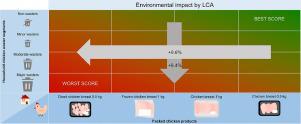Resources, Conservation and Recycling ( IF 11.2 ) Pub Date : 2021-12-04 , DOI: 10.1016/j.resconrec.2021.106089 Margot Cooreman-Algoed , Lieselot Boone , Sue Ellen Taelman , Steven Van Hemelryck , Aurore Brunson , Jo Dewulf

|
The relationship between consumer behaviour, food-packaging system, and food loss and waste (FLW) has often been overlooked within environmental sustainability assessments of food products. The aim of this study was twofold: (1) to quantify the food and packaging flows of the combination of four packed chicken products and four types of household behaviour using material flow analysis, and (2) to assess the environmental profile of these combinations through life cycle assessment (LCA) within a Flemish (Belgian) context. The household behaviours described different household chicken meat waste percentages and particular household actions (e.g. storage location). The life cycle stages entailed chicken farm, poultry processing, meat cutting and packaging, distribution, retail, consumer, and end-of-life. The impact assessment method was the Environmental Footprint (2.0). The food yield—the ratio of the food amount consumed by its intended user and that entering meat cutting and packaging—of all combinations was 79.1–97.3%. The behaviour of major wasters increased the environmental impact of the food chain by 8.4% compared to the non-wasters. The impact of the product with the worst score, i.e. diced chicken breast 0.5 kg, rose 9.6% compared to the product with the best score, chicken breasts 0.5 kg. In case of the major wasters, the impact of FLW was higher by a factor of ten higher than those of the packaging materials. The single score of the average Flemish consumer or weighted average was 2.3–4.0% higher than non-wasters depending on the chicken product. These results highlight the importance of including household behaviour, FLW and packaging within food LCA research.
中文翻译:

消费者行为对食品生产和消费链环境可持续性特征的影响——以鸡肉为例
在食品的环境可持续性评估中,消费者行为、食品包装系统以及食品损失和浪费 (FLW) 之间的关系经常被忽视。本研究的目的有两个:(1) 使用材料流分析量化四种包装鸡肉产品和四种家庭行为的组合的食品和包装流,以及 (2) 通过以下方式评估这些组合的环境特征佛兰芒语(比利时)语境中的生命周期评估 (LCA)。家庭行为描述了不同的家庭鸡肉浪费百分比和特定的家庭行为(例如储存地点)。生命周期阶段包括养鸡场、家禽加工、肉类切割和包装、分销、零售、消费者和生命终结。影响评估方法是环境足迹(2.0)。所有组合的食物产量 - 其目标用户消耗的食物量与进入切肉和包装的食物量的比率 - 为79.1-97.3%。与非浪费者相比,主要浪费者的行为使食物链对环境的影响增加了 8.4%。得分最差的产品,即鸡胸肉丁0.5公斤,与得分最高的产品鸡胸肉0.5公斤相比,其影响增加了9.6%。在主要废物的情况下,FLW 的影响比包装材料的影响高 10 倍。根据鸡肉产品的不同,佛兰芒消费者的单项得分或加权平均值比非浪费者高 2.3-4.0%。这些结果强调了包括家庭行为的重要性,











































 京公网安备 11010802027423号
京公网安备 11010802027423号